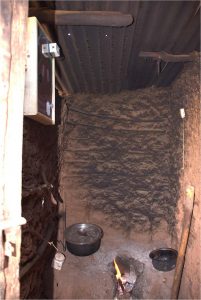 An electronic device might be able to change people’s behavior and prompt household cooks to use clean cookstoves rather than the fires and smoky stoves they are used to. To explore the question, researchers at the Mortenson Center for Global Engineering at the University of Colorado Boulder held workshops with primary household cooks in rural Rwanda to design what they believe might be behavior-changing technology.
An electronic device might be able to change people’s behavior and prompt household cooks to use clean cookstoves rather than the fires and smoky stoves they are used to. To explore the question, researchers at the Mortenson Center for Global Engineering at the University of Colorado Boulder held workshops with primary household cooks in rural Rwanda to design what they believe might be behavior-changing technology.
The device born from those talks collects air quality data in the household’s designated cooking area, displays the information to household members and audibly warns them of sudden spikes in air pollution due to the burning of solid fuels.
The researchers report on their design, as well as the human-centered design methods they employed, in an open access paper published July 16, 2020 in the Journal of Exposure Science & Environmental Epidemiology.
The air quality alert system was installed in 90 kitchens in rural Rwanda, part of a 16-week investigation into their potential to encourage cleaner cooking. Results from that research are forthcoming.
Three billion people in the world suffer daily exposure to high levels of air pollutants produced from cooking activities. These activities usually involve burning solid fuels in highly inefficient stoves, inside poorly ventilated living quarters. Often, multiple stove types and fuels are used concurrently, worsening the generated household air pollution. This practice, commonly known as “stove-stacking” – using multiple stoves at once – presents a barrier to the transition from cooking methods that pollute to cleaner stoves.
 The research team applied Human-Centered Design principles to gather insights and solicit ideas that informed the design. The team investigated barriers to adoption of cleaner cooking systems as well as factors that are likely to influence cooking decisions. Health (specifically protecting children from harmful smoke) and socio-economic and environmental factors (specifically sustaining a healthy agricultural environment) were identified as important triggers that can influence switching from solid fuels (specifically wood fuel) to cleaner cooking fuels (specifically liquefied petroleum gas).
The research team applied Human-Centered Design principles to gather insights and solicit ideas that informed the design. The team investigated barriers to adoption of cleaner cooking systems as well as factors that are likely to influence cooking decisions. Health (specifically protecting children from harmful smoke) and socio-economic and environmental factors (specifically sustaining a healthy agricultural environment) were identified as important triggers that can influence switching from solid fuels (specifically wood fuel) to cleaner cooking fuels (specifically liquefied petroleum gas).
The device involves a combination of persistent and dynamic health and environmental behavior change messaging. As the researchers write:
The resulting design is a small display system that uses an on-board air quality sensor to monitor current levels of PM2.5 in the space where it is installed. One static and two dynamic feedback systems are accessible to the user: a pro-clean cooking slogan engraved on the front of the display that says “Ishyiga ryiza, Ubuzima bwiza”, meaning “Clean stove, Good Health”, a dynamic display within a graphic of a baby’s lungs indicating current air quality, and a speaker system to generate audio feedback if a large spike in air pollution is detected.
A tool like this might be of only limited use to disadvantaged families, the researchers write. But when paired with other environmental health interventions, such as free or subsidized clean cookstoves, this new device may support the use of the stoves.
Read the paper: User-centered design of an air quality feedback technology to promote adoption of clean cookstoves

